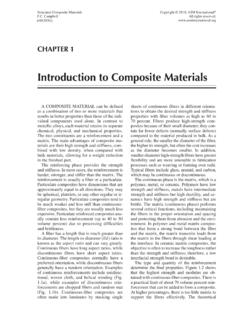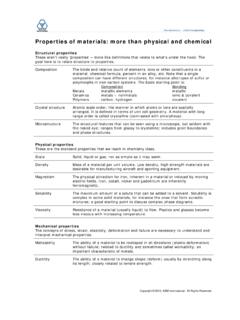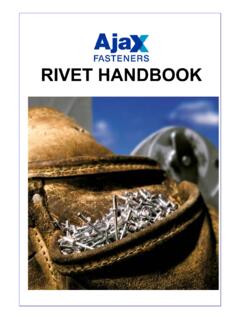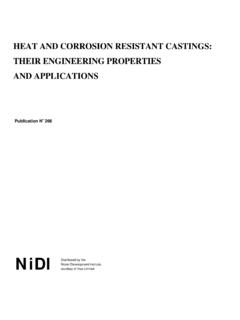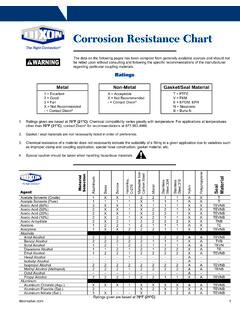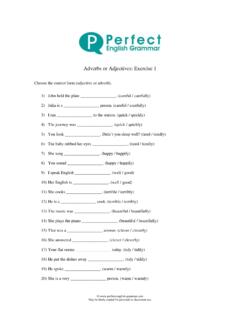Transcription of The Effects and Economic Impact of Corrosion
1 CHAPTER1 The Effects andEconomic Impact ofCorrosionCORROSION is a natural process. Just like water flows to the lowestlevel, all natural processes tend toward the lowest possible energystates. Thus, for example, iron and steel have a natural tendency to com-bine with other chemical elements to return to their lowest energystates. In order to return to lower energy states, iron and steel frequentlycombine with oxygen and water, both of which are present in most natu-ral environments, to form hydrated iron oxides (rust), similar in chemi-cal composition to the original iron ore. Figure 1 illustrates the corro-sion life cycle of a steel Steel ProductSmelting &RefiningMining OreIron Oxide (Ore & Rust)Air &MoistureCorrodeSteel & FormRustAddingEnergyGiving UpEnergyFig. 1 The Corrosion cycle of steel 2000 ASM International. All Rights : Understanding the Basics (#06691G) : Understanding the BasicsThe Definition of CorrosionCorrosion can be defined in many ways.
2 Some definitions are verynarrow and deal with a specific form of Corrosion , while others are quitebroad and cover many forms of deterioration. The word corrode is de-rived from the Latincorrodere,which means to gnaw to pieces. Thegeneral definition of corrode is to eat into or wear away gradually, as ifby gnawing. For purposes here, Corrosion can be defined as a chemicalor electrochemical reaction between a material, usually a metal, andits environment that produces a deterioration of the material and its environment consists of the entire surrounding in contact with thematerial. The primary factors to describe the environment are the follow-ing: (a) physical state gas, liquid, or solid; (b) chemical composition constituents and concentrations; and (c) temperature. Other factors canbe important in specific cases. Examples of these factors are the relativevelocity of a solution (because of flow or agitation) and mechanicalloads on the material, including residual stress within the material.
3 Theemphasis in this chapter, as well as in other chapters in this book, is onaqueous Corrosion , or Corrosion in environments where water is pres-ent. The deterioration of materials because of a reaction with hot gases,however, is included in the definition of Corrosion given summarize, Corrosion is the deterioration of a metal and is causedby the reaction of the metal with the environment. Reference to marinecorrosion of a pier piling means that the steel piling corrodes because ofits reaction with the marine environment. The environment is air-saturated seawater. The environment can be further described by speci-fying the chemical analysis of the seawater and the temperature and ve-locity of the seawater at the piling Corrosion is discussed, it is important to think of a combinationof a material and an environment. The Corrosion behavior of a materialcannot be described unless the environment in which the material is tobe exposed is identified.
4 Similarly, the corrosivity or aggressiveness ofan environment cannot be described unless the material that is to be ex-posed to that environment is identified. In summary, the Corrosion be-havior of the material depends on the environment to which it is sub-jected, and the corrosivity of an environment depends on the materialexposed to that is useful to identify both natural combinations and unnatural combi-nations in Corrosion . Examples of natural or desirable combinations ofmaterial and environment include nickel in caustic environments, leadin water, and aluminum in atmospheric exposures. In these environ-ments, the interaction between the metal and the environment does not 2000 ASM International. All Rights : Understanding the Basics (#06691G) result in detrimental or costly Corrosion problems. The combi-nation is a natural combination to provide good Corrosion combinations, on the other hand, are those that result in se-vere Corrosion damage to the metal because of exposure to an undesir-able environment.
5 Examples of unnatural combinations include copperin ammonia solutions, stainless steel in chloride-containing environ-ments ( , seawater), and lead with wine (acetic acid in wine attackslead). It has been postulated that the downfall of the Roman Empire canbe attributed in part to a Corrosion problem, specifically the storage ofwine in lead-lined vessels. Lead dissolved in the wine and consumed bythe Roman hierarchy resulted in insanity (lead poisoning) and contrib-uted to the subsequent eventual downfall. Another anecdote regardinglead and alcoholic beverages dates back to the era of Benjamin Frank-lin. One manifestation was the dry bellyache with accompanying pa-ralysis, which was mentioned by Franklin in a letter to a friend. Thismalady was actually caused by the ingestion of lead from corroded leadcoil condensers used in making brandy.
6 The problem became so wide-spread that the Massachusetts legislature passed a law in the late 1700sthat outlawed the use of lead in producing alcoholic Effects of CorrosionThe Effects of Corrosion in our daily lives are both direct, in that corro-sion affects the useful service lives of our possessions, and indirect, inthat producers and suppliers of goods and services incur corrosioncosts, which they pass on to consumers. At home, Corrosion is readilyrecognized on automobile body panels, charcoal grills, outdoor furni-ture, and metal tools. Preventative maintenance such as painting pro-tects such items from Corrosion . A principal reason to replace automo-bile radiator coolant every 12 to 18 months is to replenish the corrosioninhibitor that controls Corrosion of the cooling system. Corrosion pro-tection is built into all major household appliances such as water heat-ers, furnaces, ranges, washers, and far more serious consequence is how Corrosion affects our livesduring travel from home to work or school.
7 The Corrosion of steel rein-forcing bar (rebar) in concrete can proceed out of sight and suddenly (orseemingly so) result in failure of a section of highway, the collapse ofelectrical towers, and damage to buildings, parking structures, andbridges, etc., resulting in significant repair costs and endangering pub-lic safety. For example, the sudden collapse because of Corrosion fa-tigue of the Silver Bridge over the Ohio River at Point Pleasant, OH in1967 resulted in the loss of 46 lives and cost millions of Effects and Economic Impact of Corrosion3 2000 ASM International. All Rights : Understanding the Basics (#06691G) most dangerous of all is Corrosion that occurs in major indus-trial plants, such as electrical power plants or chemical processingplants. Plant shutdowns can and do occur as a result of Corrosion . This isjust one of its many direct and indirect consequences.
8 Some conse-quences are Economic , and cause the following: Replacement of corroded equipment Overdesign to allow for Corrosion Preventive maintenance, for example, painting Shutdown of equipment due to Corrosion failure Contamination of a product Loss of efficiency such as when overdesign and Corrosion productsdecrease the heat-transfer rate in heat exchangers Loss of valuable product, for example, from a container that has cor-roded through Inability to use otherwise desirable materials Damage of equipment adjacent to that in which Corrosion failure occursStill other consequences are social. These can involve the following is-sues: Safety, for example, sudden failure can cause fire, explosion, releaseof toxic product, and construction collapse Health, for example, pollution due to escaping product from corrodedequipment or due to a Corrosion product itself Depletion of natural resources, including metals and the fuels used tomanufacture them Appearance as when corroded material is unpleasing to the eyeOf course, all the preceding social items have Economic aspects also(see the discussion that follows, Economic Impact of Corrosion ).
9 Clearly, there are many reasons for wanting to avoid Many Forms of CorrosionCorrosion occurs in several widely differing forms. Classification isusually based on one of three factors: Nature of the corrodent: Corrosion can be classified as wet or dry. A liquid or moisture is necessary for the former, and dry corro-sion usually involves reaction with high-temperature gases. Mechanism of Corrosion :This involves either electrochemical or di-rect chemical : Understanding the Basics 2000 ASM International. All Rights : Understanding the Basics (#06691G) Appearance of the corroded metal: Corrosion is either uniform andthe metal corrodes at the same rate over the entire surface, or it is lo-calized, in which case only small areas are by appearance, which is particularly useful in failureanalysis, is based on identifying forms of Corrosion by visual observa-tion with either the naked eye or magnification.
10 The morphology of at-tack is the basis for classification. Figure 2 illustrates schematicallysome of the most common forms of forms of wet (or aqueous) Corrosion can be identified based onappearance of the corroded metal. These are: Uniform or general Corrosion Pitting Corrosion Crevice Corrosion , including Corrosion under tubercles or deposits,filiform Corrosion , and poultice Corrosion Galvanic Corrosion Erosion- Corrosion , including cavitation erosion and fretting corro-sion Intergranular Corrosion , including sensitization and exfoliation Dealloying, including dezincification and graphitic Corrosion Environmentally assisted cracking, including stress- Corrosion crack-ing, Corrosion fatigue, and hydrogen damageIn theory, the eight forms of Corrosion are clearly distinct; in practicehowever, there are Corrosion cases that fit in more than one Corrosion cases do not appear to fit well in any of the eight catego-ries.








